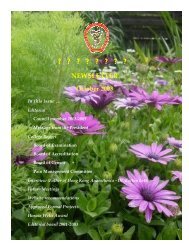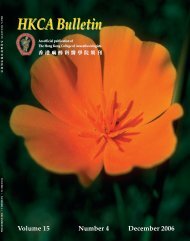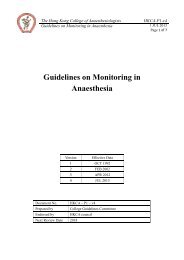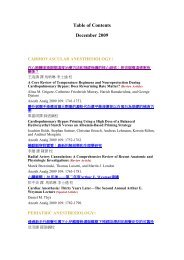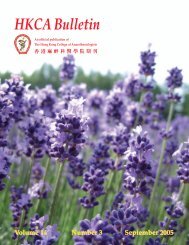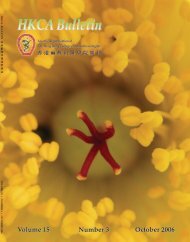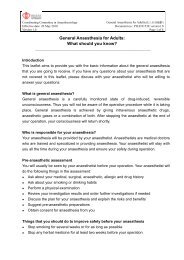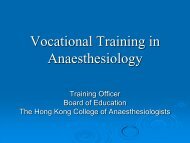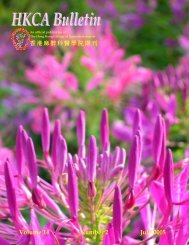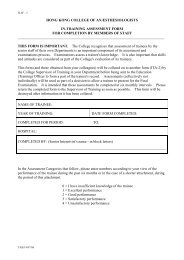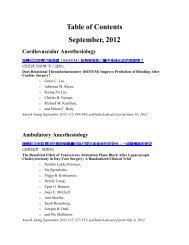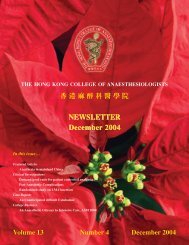HKCA Newsletter, Volume 11, No.1 - The Hong Kong College of ...
HKCA Newsletter, Volume 11, No.1 - The Hong Kong College of ...
HKCA Newsletter, Volume 11, No.1 - The Hong Kong College of ...
- No tags were found...
Create successful ePaper yourself
Turn your PDF publications into a flip-book with our unique Google optimized e-Paper software.
香 港 麻 醉 科 醫 學 院NEWSLETTERIn this issue …<strong>College</strong> ReportsBoard <strong>of</strong> EducationBoard <strong>of</strong> ExaminationBoard <strong>of</strong> AccreditationBoard <strong>of</strong> CensorPain Management CommitteeMeeting ReportWhat’s new in anaesthetic pharmacology?Extraordinary anaesthesiaFormal Project PrizeFuture Meetings<strong>Volume</strong> 13 Number 1 January 20041
<strong>HKCA</strong> <strong>Newsletter</strong> <strong>Volume</strong> 13, Number 1 January, 2004ContentsPages3. Editorial4. <strong>The</strong> Council 2003‐20055. Board <strong>of</strong> Education report ‐ ITA and eLogBook6. Board <strong>of</strong> Examination report ‐ Examiner’s workshop7. Changes in Intermediate Fellowship Examination Format8. Examination Dates, 20049. Board <strong>of</strong> Accreditation report10. Board <strong>of</strong> Censor report<strong>11</strong>. New Policy on “Fellow ad eundem”12. Pain Management Committee report13. Meeting report: Combined Scientific Meeting in Anaesthesiology 200317. Recent Advances in Anaesthesia18. What’s new in anaesthetic pharmacology?Peripheral opioid antagonistsPost‐operative nausea and vomitingAdvances in intravenous anaesthesia24. Extraordinary anaesthesia26. My extra‐ordinary paediatric list30. Recent Meetings: Anaesthesia, Intensive Care & Pain management33. Formal Project Prize34. Revision Course in Anaesthesiology 200336. Intermediate Examination Mock Viva 2004Instruction to ContributorsWe welcome contributions from invited guests and members / fellows <strong>of</strong> the <strong>Hong</strong> <strong>Kong</strong> <strong>College</strong> <strong>of</strong>Anaesthesiologists. Articles should be prepared with suitable word processing s<strong>of</strong>tware. Figures, table,pictures and photo‐micrographs should be saved in the same file. <strong>The</strong> file could be sent either by e‐mailor by post (on a floppy disc or CD) to the Editor. Please indicate if the material has to be returned afterthe editorial processing. <strong>The</strong> article would be printed in the same way as it is submitted. <strong>The</strong> accuracy<strong>of</strong> the materials published is the responsibility <strong>of</strong> the contributors. <strong>The</strong> contributors must ensure thatthe materials submitted do not infringe copyright. <strong>The</strong> editorial board reserves the editorial right forselection <strong>of</strong> publication.DisclaimerUnless specifically stated otherwise, the opinions expressed in this newsletter are those <strong>of</strong> the author’spersonal observations and do not necessarily reflect the <strong>of</strong>ficial policies <strong>of</strong> the <strong>Hong</strong> <strong>Kong</strong> <strong>College</strong> <strong>of</strong>Anaesthesiologists.2
<strong>HKCA</strong> <strong>Newsletter</strong> <strong>Volume</strong> 13, Number 1 January, 2004EditorialIt has been twelve years since we started the <strong>College</strong> <strong>Newsletter</strong> in 1992. Much credit should go tomy predecessors: Pr<strong>of</strong>essor Chandra Rodrigo, Drs. TW Lee, Anne Kwan and Timmy Yuen for theirhard work and dedications. Since the first issue, there have been a lot <strong>of</strong> changes in the newsletter. Inthe last couple <strong>of</strong> years, we have been interviewing prominent figures in <strong>Hong</strong> <strong>Kong</strong> Anaesthesia (Drs.Amy Lam, Peter Kam and Zoltan Lett). We have learnt a lot from their experience. Starting from thecurrent issue, we wish to increase the academic content <strong>of</strong> the newsletter. Dr. SC Yu and his team inTsang Kwan O Hospital have written a series <strong>of</strong> articles entitled “What’s new in anaestheticpharmacology?” I am sure you will find them most interesting. Furthermore, we wish to highlight thepr<strong>of</strong>iles <strong>of</strong> our fellows and members. In this issue, Drs. Ge<strong>of</strong>frey Lam (and his mentor Dr. Kevin Chan)and Anita Chan will share with us their “extraordinary” anaesthetic experience.<strong>The</strong> <strong>College</strong> newsletter is primarily a communication tool between the <strong>College</strong> and our fellowmembers. We are always looking for stimulating thoughts and ideas from our colleagues. If you haveanything that you wish to tell us, be it academic or extracurricular, please send it to us. We will alsoconsider publishing formal project. In the years to come, we hope to maintain the newsletter as aregular (quarterly for the time being) publication. Your contribution will be highly appreciated.Finally, I wish to thank our sponsor, GlaxoSmithKline, <strong>Hong</strong> <strong>Kong</strong>, for their unrestricted support. Iam please to announce that GSK, <strong>Hong</strong> <strong>Kong</strong> has agreed to bring this newsletter to you, free <strong>of</strong> charge,for the coming 12 months.On behalf <strong>of</strong> the editorial board, I wish you all a happy new year (<strong>of</strong> Monkey).<strong>The</strong> Editorial BoardMatthew ChanEditor‐in‐ChiefEditor‐in‐ChiefBoard MemberMatthew ChanPo Wah CheungEdmond ChungDouglus FokRebecca KwokW H KwokBassanio LawAnne LeungCarina LiDavid LimHS LimVivian NgMichael PoonEric SoSteven WongSC YuTimmy YuenEmail: hkeditor@hkca.edu.hkAddress: Department <strong>of</strong> Anaesthesia and Intensive Care, Chinese University <strong>of</strong> <strong>Hong</strong> <strong>Kong</strong>, Prince <strong>of</strong>Wales Hospital, Shatin, NT, <strong>Hong</strong> <strong>Kong</strong>Phone: 2632 2894; Fax: 2637 24223
<strong>The</strong> Council 2003‐2005Back row (Left to Right): Drs. Anne Kwan, Edward Ho, Gavin Joynt, PP Chen, CT Hung, and TW LeeFront row (Left to Right): Drs. Simon Chan, Joseph Lui, PT Chui, Pr<strong>of</strong>essor Tony Gin, Drs. <strong>The</strong>resa Hui, YF Chow, and Matthew Chan4
<strong>HKCA</strong> <strong>Newsletter</strong> <strong>Volume</strong> 13, Number 1 January, 2004Board <strong>of</strong> Education<strong>The</strong> Council has resolved to implement In‐Training Assessment (ITA) and electronic logging <strong>of</strong>trainees’ experience from 1 st July, 2004.In‐Training AssessmentITA is intended to focus primarily on the attainment <strong>of</strong> clinical skills, attitudes and behavior forcompetent pr<strong>of</strong>essional practice. It complements other methods <strong>of</strong> evaluation such as the <strong>College</strong>’sexaminations. ITA is an essential part <strong>of</strong> the traineeʹs education and development.<strong>The</strong> Objectives <strong>of</strong> ITA are to:(a) Assess and assist with the Trainee’s progress towards appropriate pr<strong>of</strong>essional competence. ITA isintended to focus primarily on areas not formally or easily assessed in examinations, including:clinical skills and attitudes, behavior skills and attitudes and academic skills and attitudes(b) Provide regular feedback to the Trainee(c) Develop any remedial activities that may be required for the Trainee.If you are interested in how trainees are being assessed, a copy <strong>of</strong> the ITA form is available in thecollege website: www.hkca.edu.hk/ITASOT.pdfeLogBook<strong>The</strong> eLogBook can be found at: www.aic.cuhk.edu.hk/hkca/hkca.htm and is now opened for trial. Toenter the eLogBook, ask your supervisor <strong>of</strong> training for an eligible password. A comprehensiveguideline for entering experience in the eLogBook will appear in the “help” section shortly.YF ChowTraining Officer5
<strong>HKCA</strong> <strong>Newsletter</strong> <strong>Volume</strong> 13, Number 1 January, 2004Board <strong>of</strong> ExaminationI am privileged to be appointed as Chairman <strong>of</strong> the Board <strong>of</strong> Examination from 2004. It is achallenge to run the <strong>College</strong> Examinations, which reflect and also influence the standards <strong>of</strong> training <strong>of</strong>our trainees. I am indebted to the former Chairpersons, Pr<strong>of</strong> Tony Gin and Pr<strong>of</strong> Cindy Aun. <strong>The</strong>y havelaid down the foundation that enables the <strong>College</strong> to hold independent Fellowship examinations.Examiners Workshop 2004<strong>The</strong> <strong>College</strong> endeavors to ensure fairness and validity <strong>of</strong> the <strong>College</strong> examinations. <strong>The</strong> <strong>College</strong>plans to hold another examiners workshop in 2004. <strong>College</strong> examiners and interested Fellows will beinformed <strong>of</strong> the event once we have the details finalized.We are grateful to ANZCA and RCA for sending their Examiners to <strong>Hong</strong> <strong>Kong</strong> as externalexaminers. <strong>The</strong>y help to ensure that our candidates’ knowledge, skills, and judgment are comparable tointernational standards. <strong>The</strong>y also update our examiners on the methods and techniques inpostgraduate examinations.Recruitment <strong>of</strong> ExaminersI like to remind Fellows that the Board <strong>of</strong> Examination needs new examiners from time to time.Interested Fellows can obtain the application form and information on duties <strong>of</strong> examiners, andcriteria for appointment <strong>of</strong> examiners from the <strong>College</strong> <strong>of</strong>fice (Phone: 2814 1029, Fax: 2871 8833,Email: <strong>of</strong>fice@hkca.edu.hk,).PT ChuiChairman, Board <strong>of</strong> Examination6
<strong>HKCA</strong> <strong>Newsletter</strong> <strong>Volume</strong> 13, Number 1 January, 2004Changes in Intermediate Fellowship Examination Formatfrom July/August 2004From time to time, the Board <strong>of</strong> Examination reviews the examination format. From theJuly/August 2004 Intermediate Fellowship examination onwards, the oral examination willincrease from one 20‐minute table to two 20‐minute tables in each <strong>of</strong> Physiology andPharmacology. <strong>The</strong> change will allow more extensive coverage <strong>of</strong> topics. We believe this will givecandidates more systematic assessment and better chance <strong>of</strong> passing the examination. Also fromJuly/August 2004, Intermediate Fellowship examination candidates will be invited to the oralexamination only if they have achieved an acceptable standard in the written papers. This is toallow the examiners to spend more time and focus the oral examination with candidates who areable to pass the examination. We hope this change will also give the candidates a strongerincentive to finalize their examination preparation before the written section.Existing FormatWritten ExaminationNew Format(from July, 2004)Written ExaminationPhysiology12 SAQsPharmacology12 SAQsPhysiology12 SAQsPharmacology12 SAQsAchieved an acceptable standardViva VoceViva VocePhysiology20 minutesPharmacology20 minutesPhysiology 120 minutesPhysiology 220 minutesPharmacology 120 minutesPharmacology 220 minutesSuccessful in Intermediate Examination7
<strong>HKCA</strong> <strong>Newsletter</strong> <strong>Volume</strong> 13, Number 1 January, 2004Intermediate Fellowship Examinations 2004Examination Fee: $6,500Examination Dates, 2004February / MarchWrittenOralDate6 February 2004 (Fri)12/13 March 2004 (Fri/Sat)July / AugustWrittenOralClosing DateDate2 July 2004 (Fri)13/14 August 2004 (Fri/Sat)2 June 2004 (Wed)Final Fellowship Examinations in Anaesthesiology 2004Examination Fee: $10,000March / MayWrittenOral/OSCEClosing DateDate19 March 2004 (Fri)7/8 May 2004 (Fri/Sat) ± 9 May (Sun)19 February 2004 (Thu)July / AugustWrittenOral/OSCEClosing DateDate9 July 2004 (Fri)27/28 August 2004 (Fri/Sat) ± 29 Aug (Sun)9 June 2004 (Wed)Exit Assessment Date for Year 2004Examination Fee: $5,000 for Fellow ad eundem08 April 2004 (Thu)08 July 2004 (Thu)07 October 2004 (Thu)Trainees who are qualified to apply for fellowship are recommended to have their respectively applicationsreceived at the <strong>HKCA</strong> <strong>of</strong>fice at least 21 days before the scheduled Exit Assessment dates, to allowample time for processing.8
<strong>HKCA</strong> <strong>Newsletter</strong> <strong>Volume</strong> 13, Number 1 January, 2004Board <strong>of</strong> Accreditation<strong>The</strong> past few months have been particularly busy, with plenty <strong>of</strong> issues concerning ouraccreditation system. Our old training system is up for revamp. <strong>The</strong> Boards <strong>of</strong> Education andAccreditation are jointly revising <strong>College</strong> guidelines and regulations to make way for the new system.Cluster hospitals and supervisors are also heavily involved in perfecting the new system by ways <strong>of</strong>advice and modifying their own training patterns. <strong>The</strong> BOA is targeting an inspection exercise sometime in mid‐year 2004 to allow for implementation <strong>of</strong> the new training system in January 2005.Even our existing training system is not without problems. In NTE cluster major changes havetaken place in two hospitals and some interim arrangements have to be made from our Board in orderto maintain training standards and allow for a smoother transition to the new modular system. Someclusters are not yet fully formed and others have problems related to attrition and poor funding. Newtrainees have to face a dual blow <strong>of</strong> uncertain prospects and tougher training requirements.<strong>The</strong> Board <strong>of</strong> Pain Management has inspected both the NTE cluster and Queen Mary Hospital’spain training programmes, and their recommendations will be released later.<strong>The</strong> ICU committee has also received an application for training recognition from the PrincessMargaret Hospital’s Intensive Scare Unit. A report will be provided later.I would like to thank all board members for their time and generosity in helping with all activities<strong>of</strong> our board. I wish them a Happy New Year.John LiuChairman, Board <strong>of</strong> Accreditation9
<strong>HKCA</strong> <strong>Newsletter</strong> <strong>Volume</strong> 13, Number 1 January, 2004Board <strong>of</strong> CensorAdmission to Fellowship by Examination, F<strong>HKCA</strong>CHENG Pui Gee, BonnieCHOI Wing Yee, ReginaCHEUNG Wing Wai, RochelleCHENG Man Tung, TonyAdmission to Fellowship ad eundem, F<strong>HKCA</strong>LIU Kwok KuenNew MembersYUNG Hoi LingNG Nga Lai AliceKHU Kin FaiPOON Ching Mei, ClaraKONG Hang Sze, AmyFU Yim Ting, ZoeCHEUNG Chuen HoFAN Lawrence Tak YanCHU Chung YinCHAN Kai ManYUE Man Cheung, StephenIP Ka LunKOO Emily Gar YeeKAM Hau TsuLAM Yuk KeungCHUI Sze WingMichael IrwinChairman, Board <strong>of</strong> Censor10
<strong>HKCA</strong> <strong>Newsletter</strong> <strong>Volume</strong> 13, Number 1 January, 2004New Policy on “Fellow ad eundem”Early last year the Council has revised the policy on “Fellow ad eundem”. This was publishedin the May issue <strong>of</strong> the <strong>Newsletter</strong>. Due to the outbreak <strong>of</strong> SARS, the council has resolved todefer the date <strong>of</strong> implementation to after Annual General Meeting <strong>of</strong> 2005. <strong>The</strong> following isthe entire revised policy.A. Introduction:<strong>The</strong> regulations regarding admission <strong>of</strong> Fellow ad eundem as governed by the By‐laws <strong>of</strong> the<strong>Hong</strong> <strong>Kong</strong> <strong>College</strong> <strong>of</strong> Anaesthesiologists stipulates that:“2.3.5 Election <strong>of</strong> candidates as Fellow ad eundem shall be by the Council.2.3.6 Such election shall be held at the meeting <strong>of</strong> the Council prior to the Annual GeneralMeeting in each year but so that the number <strong>of</strong> Fellows ad eundem so admitted in eachyear shall not exceed a number to be determined each year by the Council;Such election shall be by ballot and to be admitted a candidate shall receive thefavorable vote <strong>of</strong> three quarters <strong>of</strong> the number <strong>of</strong> the members <strong>of</strong> the Councilpresent”<strong>HKCA</strong> recognizes the importance and contribution <strong>of</strong> anaesthesiologists possessing overseasanaesthesia qualifications who have decided to come and work in <strong>Hong</strong> <strong>Kong</strong>. On the other hand,<strong>HKCA</strong> has to address the issue <strong>of</strong> supply and demand <strong>of</strong> specialist anaesthesiologists. At thepresent moment, <strong>HKCA</strong> is able to produce enough specialist anaesthesiologists to satisfy the needs<strong>of</strong> <strong>Hong</strong> <strong>Kong</strong> people. It would be reasonable to set a quota for the number <strong>of</strong> “Fellows ad eundem”to be admitted each year.B. After the Annual General Meeting <strong>of</strong> 2005, the procedure for election <strong>of</strong> “Fellowad eundem” will follow strictly by‐law 2.3.6 andB.1 Not more than 5 will be admitted at such occasion.B.2 Each application will be vetted according to the spirit laid down in By‐law 2.3.2.7, whichstipulates that the applicant should have demonstrated a contribution to the advancement <strong>of</strong>the pursuits <strong>of</strong> the <strong>College</strong> in practice, education or research.B.3 If there are more than 5 applications, the most deserving ones, according to By‐law 2.3.2.7 willbe admitted. <strong>The</strong> total number <strong>of</strong> admissions may be less than 5.B.4 Unsuccessful applicants may appeal to the Appeals Committee against the decision <strong>of</strong> theBoard <strong>of</strong> Censors, or they may apply again in future when their contributions may haveincreased over time.C. Procedures for applicationC.1 <strong>The</strong> deadline for the annual application for admission as “Fellow ad eundem” will beannounced 6 months in advance.C.2 Applicants should complete the Fellowship Application Form and send it to the <strong>College</strong>secretariat together with supporting documents before the prescribed deadline.C.3 All applications will be considered together.C.4 Short listed applicants will be invited to attend an “Exit Assessment”.C.5 Successful applicants will be informed in due course.<strong>11</strong>
<strong>HKCA</strong> <strong>Newsletter</strong> <strong>Volume</strong> 13, Number 1 January, 2004Pain Management CommitteeI wish to report that all candidates who presented for the Dip Pain Mgt Examination on 17 thOctober, 2003 passed. <strong>The</strong> successful candidates wereDr CHOI Wing Yee ReginaDr KONG Suet KeiDr KWOK Fung KwaiDr LEE Ha YunDr TAY Teik GuanDr YAP Jacqueline ClaireQMHPYNEHPYNEHQMHUCHAHNH/PWOn behalf <strong>of</strong> the Pain Management Committee, I would also like to inform you that lastOctober, we submitted an application to host the <strong>HKCA</strong>/SAHK ASM 2005 as a satellite meeting<strong>of</strong> the International Association for Study <strong>of</strong> Pain (IASP)’s <strong>11</strong> th World Congress on Pain to be heldin Sydney. It is my pleasure to announce that our application had been approved by IASP. <strong>The</strong>theme <strong>of</strong> the meeting will be “East meet West in Pain Medicine”. Dr Timmy Yuen has beennominated as the Convener for the meeting.<strong>The</strong> next Pain SIG/<strong>College</strong> meeting will be held on evening <strong>of</strong> Wednesday, February 25 th 2004.<strong>The</strong> speakers will be Dr Allan Molloy and Dr Michael Nicholas. Dr Molloy is currently theDirector <strong>of</strong> Chronic and Cancer Pain Programme at the Royal North Shore Hospital and SeniorLecturer at the University <strong>of</strong> Sydney. Dr Nicholas is the Director <strong>of</strong> ADAPT Pain ManagementProgramme at the same hospital. He is an Associate Pr<strong>of</strong>essor at the University <strong>of</strong> Sydney. Pleasemake a note <strong>of</strong> the date in your diary. Details will be sent out to you in February.Wishing you all a Happy & Successful New Year!PP ChenChairman, Pain Management Committee12
<strong>HKCA</strong> <strong>Newsletter</strong> <strong>Volume</strong> 13, Number 1 January, 2004Meeting report: Combined Scientific Meeting in Anaesthesiology 2003Pharmacology from bench to bedside<strong>The</strong> Combined Scientific Meeting in Anesthesiology 2003 convened on 26 th September 2003 at theSheraton <strong>Hong</strong> <strong>Kong</strong> Hotel & Towers, <strong>Hong</strong> <strong>Kong</strong>. This year the meeting was jointly organized by the<strong>College</strong>, the Society <strong>of</strong> Anaesthetists <strong>of</strong> <strong>Hong</strong> <strong>Kong</strong> and the International Society for AnaestheticPharmacology (ISAP). <strong>The</strong> meeting was also the 4th Congress <strong>of</strong> the Asian Oceanic Society forIntravenous Anaesthesia (AOSIVA). Although many <strong>of</strong> our overseas colleagues were unable to come forvarious reasons, our symposia, lectures and workshops were well attended by 250 delegates from all overthe world (Australia, Canada, Denmark, Germany, Korea, Malaysia, Nepal, Netherlands, New Zealand,Singapore, South Africa, Thailand, USA and United Kingdom).For those who are not familiar with AOSIVA, the society was established on the 21 st November, 1996in Tokyo by representatives <strong>of</strong> five Asian and Oceanic national societies for anesthesiology. <strong>The</strong> foundingpresident was Pr<strong>of</strong>essor Kenjiro Mori. It was inaugurated as a counterpart to ISAP and the EuropeanSociety <strong>of</strong> Intravenous Anaesthesia (EuroSIVA). <strong>The</strong> goal <strong>of</strong> AOSIVA is to make a contribution from thispart <strong>of</strong> the globe to the efforts <strong>of</strong> a worldwide group <strong>of</strong> anesthesiologists engaged in science, technology,practice and education within this new and growing field.Over the two‐day meeting, a total <strong>of</strong> six keynote lectures and seven symposia were presented. <strong>The</strong>material covered basic sciences in anesthetic pharmacology (from molecular action <strong>of</strong> prop<strong>of</strong>ol tocomplex pharmacokinetic‐pharmacodynamic interactions) as well as clinical topics including targetcontrolled infusion and perioperative management <strong>of</strong> pain, nausea and vomiting. <strong>The</strong> TIVA trainerworkshops were run by our EuroSIVA representatives lead by Pr<strong>of</strong>essor Gavin Kenny (Glasgow, UK).For those who missed out on this great event, the abstracts are now available from our website(www.aosiva.org) for review. We believe there is something for everyone.Finally, we wish to thank our sponsors. Without their contribution, this event will not be possible. Weare looking forward to seeing you again in the coming Annual Scientific Meeting, 2004.Matthew Chan and Mike IrwinOrganizing committee, <strong>The</strong> Combined Scientific Meeting in Anesthesiology 2003Koyoto InternationalConference Hall, Koyoto,Japan, 15‐27 February, 1998Hotel S<strong>of</strong>itel,Melbourne, Australia27‐29 October, 1999Sheraton Walker HillHotel, Seoul, Korea13‐15 September, 2001Sheraton <strong>Hong</strong> <strong>Kong</strong> Hotel,<strong>Hong</strong> <strong>Kong</strong>26‐28 September, 200313
<strong>HKCA</strong> <strong>Newsletter</strong> <strong>Volume</strong> 13, Number 1 January, 2004Name four errors in this flyer…Your entry should be sent to the Editor via Email (hkeditor@hkc.edu.hk) by 31 st March, 2004. One prize will bedrawn from all correct responses.Answers and winner will be announced in the next issue <strong>of</strong> the newsletter. (Sponsored by GSK, <strong>Hong</strong> <strong>Kong</strong>)Conference Lunch, Lucky Draw…and the winner is Dr. Winnie <strong>Hong</strong>(Sydney, Australia), a special prize presentedby Dr. Tim Short (Auckland, New Zealand)14
<strong>HKCA</strong> <strong>Newsletter</strong> <strong>Volume</strong> 13, Number 1 January, 2004Pr<strong>of</strong>essor Johan Coetzee (Stellenbosch,South Africa) describing his Stelpump.TIVA trainer Workshop(Left to right) Gavin Kenny (Glasgow,UK), Frank Engbers (Netherland) andStefan Schraag (Ulm, Germany)15
<strong>HKCA</strong> <strong>Newsletter</strong> <strong>Volume</strong> 13, Number 1 January, 2004Dr. Tong Gan (Duke University, Durham,USA)Dr. Thiam Lim (Malaysia)Dr. Talmage Egan (Utah, USA)sharing his surfing experience.16
<strong>HKCA</strong> <strong>Newsletter</strong> <strong>Volume</strong> 13, Number 1 January, 2004Recent Advances in AnaesthesiaPress Conference(Left to right) Drs. Tong Gan, KF Ng, Pr<strong>of</strong>s.Gavin Kenny and Mike IrwinIf you wish to read the fulltext <strong>of</strong> these newspaper clippings, please visit the college website www.hkca.edu.hk.17
<strong>HKCA</strong> <strong>Newsletter</strong> <strong>Volume</strong> 13, Number 1 January, 2004Peripheral Opioid antagonistsDr. SC YuAssociate ConsultantDepartment <strong>of</strong> AnaesthesiaTseung Kwan O HospitalOpioids are one <strong>of</strong> the major classes <strong>of</strong> drugs for perioperative analgesia and pain medicine. Opioidreceptors are widely distributed throughout the body with analgesia mediated largely by the mu receptorsubgroup. Unfortunately, many <strong>of</strong> the side effects are also related to mu receptors and may be severeenough to restrict opioid use.Analgesia is mainly centrally mediated effect, yet some side effects may be due to peripheral opioidreceptor agonism. Traditional opioid antagonists, such as naloxone or naltrexone (figure 1), are successfulin reversing opioid side effects. <strong>The</strong>se compounds can also cross the blood brain barrier (BBB) resulting inreversal <strong>of</strong> the central effects <strong>of</strong> opioids, including recurrence <strong>of</strong> pain or precipitation <strong>of</strong> withdrawalsymptoms in chronic opioid use patients. Hence the development <strong>of</strong> peripheral opioid antagonists toprevent opioid side effects whilst maintaining analgesia without withdrawal symptoms.NH 2CHOPharmacologyHOOOFigure 1. Structure <strong>of</strong> naltrexoneTwo peripheral opioid antagonists are in evaluation. Methylnaltrexone (Figure 2) is the quaternaryderivative <strong>of</strong> naltrexone. Placement <strong>of</strong> a methyl group to the amine ring results in a charged molecule lessable to penetrate the blood brain barrier. It can be administered intravenously or orally.CH 3H 2N CHOHOOOFigure 2. Structure <strong>of</strong> methylnaltrexoneAlvimopan (ADL 8‐2698) (figure 3) is a piperidine with a zwitterionic form and polarity that restrictsits passage across the blood brain barrier and gastrointestinal tract. It is administered in the oral form.18
<strong>HKCA</strong> <strong>Newsletter</strong> <strong>Volume</strong> 13, Number 1 January, 2004CH 3HOH 3 CNHHNOO2H 2 OOFigure 3. AlvimopanGastrointestinal effectsOpioids decrease gastric emptying time, intestinal motility and cause constipation predominantly bya peripheral effect. Naloxone can successfully treat the constipation in patients with chronic opioid usebut with recurrence <strong>of</strong> pain and withdrawal symptoms. Methylnaltrexone, when given to patients withchronic methadone consumption, was able to improve gastric motility and relieve constipation withoutinducing withdrawal symptoms. Alvimopan has been shown to decrease the time for recovery <strong>of</strong> bowelfunction in patients with major bowel surgery. This may be associated with decreased time to hospitaldischarge. Alvimopan is also effective in relieving constipation in patients with chronic opioidconsumption.Nausea and vomitingOpioids induce nausea and vomiting by acting on the chemoreceptor trigger zone (CTZ) which liesoutside the BBB. Thus the CTZ is accessible to peripheral opioid antagonists. Initial data suggests thatboth methylnaltrexone and alvimopan can reduce postoperative nausea and vomiting. Since alvimopan ispoorly absorbed from the gastrointestinal tract, this reduction <strong>of</strong> nausea and vomiting is probablymediated in part by a peripheral mechanism.Other potential directionsPeripheral opioid antagonists may have a role in preventing the effects on patients withpostoperative ileus who receive exogenous opioids or in the intensive care unit where patients receiveopioids for sedation. <strong>The</strong> role <strong>of</strong> peripheral opiate antagonists in reversal <strong>of</strong> pruritis, biliary spasm,urinary retention secondary to opioids are as yet undefined. It has been speculated that peripheral opioidantagonists could reduce the depression <strong>of</strong> immune function that occurs with opioids. Respiratorydepression from overdose <strong>of</strong> opioids is a central effect. <strong>The</strong>refore, peripheral opioid antagonists wouldnot be expected to reverse this side effect.Selected referencesBates JJ, Foss JF, Murphy DB. Are peripheral opioid antagonists the solution to opioid side effects?Anesth Analg 2004;98:<strong>11</strong>6‐22Taguchi A. Sharma N. Saleem RM. Sessler DI. Carpenter RL. Seyedsadr M. Kurz A. Selectivepostoperative inhibition <strong>of</strong> gastrointestinal opioid receptors. N Engl J Med 2001;345:935‐4019
<strong>HKCA</strong> <strong>Newsletter</strong> <strong>Volume</strong> 13, Number 1 January, 2004Post‐operative nausea and vomitingDr. WM LauAssociate ConsultantDepartment <strong>of</strong> AnaesthesiaTseung Kwan O HospitalPost‐operative nausea and vomiting (PONV) is the most common complication for both inpatientsand outpatients undergoing virtually all types <strong>of</strong> surgical procedures, regardless <strong>of</strong> the anestheticregimen used. Among high‐risk patients, the incidence <strong>of</strong> PONV can be frequent as 70% to 80%. PONV isnot only a triad <strong>of</strong> signs and symptoms but also the unpleasant subjective feeling experienced by thepatient. Patients report that avoidance <strong>of</strong> PONV is <strong>of</strong> greater concern than avoidance <strong>of</strong> post‐operativepain and are willing to spend up to US$100 out <strong>of</strong> pocket for an effective antiemetic. PONV can lead toincreased recovery room time, expanded nursing care, and potential hospital admission‐ all factors thatmay increase total health costs.<strong>The</strong> introduction <strong>of</strong> serotonin antagonists in the early 1990’s <strong>of</strong>fered considerable promise for themanagement <strong>of</strong> PONV. Anti‐5HT3 (ondansetron, dolasetron, granisetron) are currently approved for themanagement <strong>of</strong> PONV. Granisetron, tropisetron, ramosetron, and palonosetron are effective for themanagement <strong>of</strong> PONV.Prophylactic administration has been shown to decrease the incidence <strong>of</strong> PONV in various patientpopulations. For ondansetron, the optimal dose for prophylaxis seems to be 4mg administeredintravenously at the end <strong>of</strong> surgery, prior to emergence with a number needed to be treated (NNT) <strong>of</strong> 6.<strong>The</strong> NNT indicates efficacy <strong>of</strong> the therapy; that is for every 6 patients, one will benefit. When used fortreatment, 1mg <strong>of</strong> ondansetron administered intravenously is as effective as higher doses (NNT = 4). <strong>The</strong>optimal dose <strong>of</strong> dolasetron appears to be 12.5 mg for both prevention and treatment with NNT similar toondansetron.Droperidol in doses <strong>of</strong> either 0.625 mg or 1.25 mg compares favorably with ondansetron 4mg inoutpatients. <strong>The</strong> NNT for early nausea is 5 while the NNT for early and late vomiting is 7. <strong>The</strong>re is nodifference in side effect pr<strong>of</strong>iles, including sedation, extrapyramidal reactions or cardiac arrhythmiabetween the ondanstron and droperidol‐treated patients when these drugs are used. On December 5,2001, the FDA issued a ‘black box’ warning on droperidol that it should only be used when other first‐linetherapy fails. It is related to death associates with QTc prolongation and torsades de pointes in 9 patientstreated with doses <strong>of</strong> droperidol well below the approved range. <strong>The</strong> FDA went on to warn that allpatients should undergo a 12‐lead ECG prior to administration <strong>of</strong> droperidol to determine if a prolongedQTc interval is present, and to continue ECG monitoring for 3 hours after administration. Since low‐dosedroperidol is most commonly used on outpatients undergoing ambulatory surgery, theserecommendations would be impractical and costly to the patients and the healthcare system.Dexamethasone, administered as prophylatic dose <strong>of</strong> 8‐10 mg IV, effectively prevent nausea andvomiting with a NNT = 4. More recently, small doses (2.5‐5 mg) have been found to be as effective.Lack <strong>of</strong> evidence <strong>of</strong> effect: 10mg IV metoclopramide is ineffective for PONV prophylaxis.Cannabinoids, although promising in the control <strong>of</strong> chemotherapy‐induced sickness, have not shownantiemetic efficacy in the PONV setting.20
<strong>HKCA</strong> <strong>Newsletter</strong> <strong>Volume</strong> 13, Number 1 January, 2004Advances in Intravenous AnaesthesiaDr. HS LimAssociate ConsultantDepartment <strong>of</strong> AnaesthesiaTseung Kwan O HospitalA major recent advancement is the application <strong>of</strong> total intravenous anaesthesia (TIVA). This, however,requires some understanding <strong>of</strong> the relevant intravenous pharmacology.<strong>The</strong> concept <strong>of</strong> context sensitive half times (CSHT) is important. This is the time necessary to achieve a50% decrease in drug concentration after termination <strong>of</strong> a variable length continuous infusion to asteady drug level. Other than drug elimination, it also takes into account the size as well as redistribution<strong>of</strong> drugs to peripheral compartment/s. Thus it gives a more accurate prediction <strong>of</strong> druglevel following cessation <strong>of</strong> infusion.Using raw population pharmacologic (drug level) data, pharmacokinetic (PK) parameters (e.g.distribution half‐lives, volume <strong>of</strong> distribution) can be generated via computerized non‐linear regressionanalysis. Together with CSHT, we will be able to predict the drug level following intravenousadministration. When coupled with pharmacodynamic (PD) effect (e.g. hypnosis, analgesia), a PK‐PDmodeling can be derived (see Fig 1). This will then allow us to achieve the necessary anaesthetic endpoint(e.g. hypnosis) by attaining the required target drug concentration, with the help <strong>of</strong> a computer ormedical device (e.g. Diprifusor for titrating prop<strong>of</strong>ol level).Figure 1Following administration, a drug distributes among the different body compartments (C1, C2, C3, Ce)before being eliminated. It also achieve an effect site concentration necessary for an effect. <strong>The</strong> PK‐PDmodeling then accounts for the latency to peak effect, magnitude and duration <strong>of</strong> effect. This allows usto predict the duration and magnitude <strong>of</strong> drug effect in any given patient in a specific population.<strong>The</strong> next step is how to “fine tune” our infusion to give a safe anaesthesia but avoid unnecessary delayin emergence. We can titrate drug to achieve a pre‐defined drug effect using the feedback mechanism(pharmacologic approach) or achieve a target drug level known to be associated with certainanaesthetic end‐point (pharmacokinetic approach). Likewise, titration <strong>of</strong> short‐acting agents along the22
<strong>HKCA</strong> <strong>Newsletter</strong> <strong>Volume</strong> 13, Number 1 January, 2004steep portion <strong>of</strong> the dose‐response curve will help us to achieve the required pharmacodynamics effect(pharmaceutical approach) rapidly (1).<strong>The</strong> knowledge <strong>of</strong> drug interaction and synergy is also important. This is especially so when two drugswith different mechanism <strong>of</strong> actions but similar therapeutic effect are administered for anaesthesia. Thissynergism will allow drugs to be given at a smaller dose but yet achieving the same anaesthetic goalswith less adverse effects and better recovery pr<strong>of</strong>iles. <strong>The</strong> classic example is the prop<strong>of</strong>ol‐opioidinteraction. Using computer predictions <strong>of</strong> optimal dose combination <strong>of</strong> prop<strong>of</strong>ol and opioid, we canachieve adequate anaesthesia with different emphasis on anaesthetic requirement. For example, we canemploy a prop<strong>of</strong>ol‐based anaesthesia with a much smaller opioid dose for patient prone to postoperativenausea/vomiting, or a primarily opioid‐based anaesthesia with a fractional dose <strong>of</strong> prop<strong>of</strong>olfor providing intense analgesia without compromising anaesthesia.<strong>The</strong> formulation <strong>of</strong> anaesthetic drugs cannot be over‐looked either. Let us take prop<strong>of</strong>ol as a relevantexample. Studies have shown that re‐formulation does affect the clinical characteristics <strong>of</strong> prop<strong>of</strong>ol (2,3). Since there is recent interests in developing better prop<strong>of</strong>ol formulations with less undesirableeffects (e.g. pain on injection), PK‐PD modeling will have to be repeated for these new preparations.References1. Egan TD. Advances in the clinical pharmacology <strong>of</strong> intravenous anesthesia: kinetcs, dynamics,pharmaceutic and technologic consideration. ASA Annual Meeting 2003, San Francisco.2. Dutta S, Ebling WF. Formulation‐dependent pharmacokinetics and pharmacodynamics <strong>of</strong> prop<strong>of</strong>olin rats. J Pharm Pharmacol. 1998;50:37‐42.3. Dutta S, Ebling WF. Emulsion formulation reduces prop<strong>of</strong>olʹs dose requirements and enhancessafety. Anesthesiology. 1997;87:1394‐405.23
<strong>HKCA</strong> <strong>Newsletter</strong> <strong>Volume</strong> 13, Number 1 January, 2004Extraordinary AnaesthesiaLast summer, when many <strong>of</strong> us are still recuperating from SARS outbreak, a number <strong>of</strong> our fellowsand members went to China for an extraordinary anesthetic list. We are fortunate to have twoanesthetists to share with us their “unusual” experience. We hope the two articles will stimulate somethoughts. Comments should be sent to the Editor by Email (<strong>HKCA</strong><strong>Newsletter</strong>@yahoogroups.com ormtvchan@cuhk.edu.hk).Editor24
<strong>HKCA</strong> <strong>Newsletter</strong> <strong>Volume</strong> 13, Number 1 January, 2004parents. I went to Anyang as one <strong>of</strong> the anaesthetists <strong>of</strong> a voluntary surgical team to operate on kids withthe above problems.Since it was the forth time our surgical team had worked in that particular local hospital, we workedin collaboration with local colleagues. It was very enjoyable to work with those local colleagues becausewe could share our knowledge, experience and our faith. Despite the fact that my Putonghua was reallypoor, our conversations miraculously continued. Without any sophisticated equipment and fantastictechniques, every patient woke up from their anaesthetic dosage. Although there were times that theequipment failed and the electricity supply was temporarily interrupted, our procedures were blessed soevery time the problems got sorted out without any major incidents.Unlike our everyday life where we need to rush through our operation lists, we could spend moretime with our patients and colleagues. <strong>The</strong>re were times that we could sing and read stories to ourpatients, and we could have more sharing during the perioperative period. Although we have only spentabout 12 days in Anyang, we hadreally good team spirit. I am sure youwill agree with me that it is a specialkind <strong>of</strong> job satisfaction.It was a pity that we could onlyoperate on a limited number <strong>of</strong>patients in a single visit, it is hopedthat the meaning <strong>of</strong> sharing <strong>of</strong> loveand helping one another can bespread. I hope I can go to Anyang andexperience the special meaning <strong>of</strong> lifeand work regularly. I sincerely inviteeach one <strong>of</strong> you who have the samefaith with me to go as well.Anita Chan, F<strong>HKCA</strong>Associate ConsultantPrince <strong>of</strong> Wales HospitalShatin, NT27
<strong>HKCA</strong> <strong>Newsletter</strong> <strong>Volume</strong> 13, Number 1 January, 2004Coming events …Dear colleagues,ASM 2004I am glad to announce that the <strong>College</strong> will hold an Annual Scientific Meeting in the end <strong>of</strong> Year2004. <strong>The</strong> main theme this time will be about the critical care medicine during perioperative period.<strong>The</strong> symposium will consist <strong>of</strong> scientific program and workshops. <strong>The</strong> details <strong>of</strong> ASM will soon beannounced once finalized.<strong>The</strong> Organizing Committee formed will start to prepare for such grand occasion. I hope that youall can give your full support to this event in the usual way.Wish you all have a happy and prosperous Chinese New Year.Best regards,PW CheungChairman <strong>of</strong> ASM 2004Symposium on Recombinant Factor VIIa in Surgical BleedingNew concepts in the prevention and treatment <strong>of</strong> surgical bleedingJerrold Henry Levy, MDPr<strong>of</strong>essor <strong>of</strong> Anaesthesiology, Emory University School <strong>of</strong> Medicine, Atlanta, USALocal experience <strong>of</strong> using NovoSevenAnthony HoPr<strong>of</strong>essor, Department <strong>of</strong> Anaesthesia and Intensive CareChairmanPT ChuiConsultant, Department <strong>of</strong> Anaesthesia and Intensive CareVice President, <strong>Hong</strong> <strong>Kong</strong> <strong>College</strong> <strong>of</strong> AnaesthesiologistsDate: 16 th Feb, 2004 (Monday)Venue: Sheraton <strong>Hong</strong> <strong>Kong</strong> Hotel, Tsim Sha TsuiTime: 18:30‐19:00 Reception19:00‐20:30 Lecture20:30‐21:00 DinnerSponsored by Novo Nordisk HK Ltd.28
<strong>HKCA</strong> <strong>Newsletter</strong> <strong>Volume</strong> 13, Number 1 January, 2004WORKSHOPS ORGANISED BY THE INSTITUTE OF CLINICAL SIMULATIONA Collaboration between the <strong>Hong</strong> <strong>Kong</strong> <strong>College</strong> <strong>of</strong> Anaesthesiologists and the North District HospitalAnaesthetic Crisis Resource Management (ACRM)Date: First Saturday <strong>of</strong> each month ‐ slots available from February 2004(7 February, 6 March, 3 April, 1 May, 5 June, 3 July, 7 August, 4 September,2 October, 6 November and 4 December, 2004)Time: 08:00 – 18:00Venue:Institute <strong>of</strong> Clinical SimulationCME points: <strong>HKCA</strong> 10 pointsMax participants: 4Fee:HK$2000 per headFormat:Each registrant will participate in(1) An introduction on the METI Simulator, the anaesthetic machine for use inthe workshop and the theories <strong>of</strong> crisis management(2) Allocated time for hands‐on crisis scenario management on the METISimulator, rotating through different roles and handling different scenarios(3) A group debriefing session at completion <strong>of</strong> each scenario“Group” registration welcome if you can find your own partners to form a group <strong>of</strong> four. Mutuallyagreed dates may be arranged. Sessions will be videotaped. All participants in the workshop will berequired to sign a confidentiality statement.Difficult and Advanced Airway Management Workshop(DAAM)Time: 27 March 2004Venue:Institute <strong>of</strong> Clinical SimulationCME points: <strong>HKCA</strong> 4.5 pointsMax participants: 16Fee:HK$1,200 per headThis workshop aims at providing the participants with basic knowledge on recognition <strong>of</strong> potentialdifficult airways and practical information to handle airway crisis. <strong>The</strong>re will be hands‐on practicalsessions on different airway gadgets including trial <strong>of</strong> fibreoptic bronchoscope on virtualbronchoscopy model. <strong>The</strong>re will also be demonstration on establishing different kinds <strong>of</strong> surgicalairways. MCQ and OSCE assessment towards the end <strong>of</strong> the workshop will help the participants toapply their newly acquired skills to practice and certificates will be issued to the passing candidates.Registration will be on first come first served basis.(Application form can be downloaded from the <strong>College</strong> website: www.hkca.edu.hk)29
<strong>HKCA</strong> <strong>Newsletter</strong> <strong>Volume</strong> 13, Number 1 January, 2004Recent Meetings: Anaesthesia, Intensive Care & Pain managementLocal meetings 200431 January HONG KONG INTERNATIONAL CONFERENCE ON INFECTIOUSDISEASES (HKICID 2004)<strong>The</strong>me: New Era, New Challenges for Control <strong>of</strong> Infectious Diseases. Venue:Kowloon Shangri‐la Hotel‐la Hotel. Contact: Department <strong>of</strong> Health, Dr. L. Y. TSE,Tel: 2961 8679 Fax; 2836 0071, website: www.hkicid2004.org16 February SYMPOSIUM ON RECOMBINANT FACTOR VIIA IN SURGICAL BLEEDINGVenue: Sheraton <strong>Hong</strong> <strong>Kong</strong> Hotel, Tsim Sha Tsui, Contact: Suki Chan, Tel: 23878555, Fax: 2386 0800, Email: szec@novonordisk.com21 ‐ 22 February INTERNATIONAL HEART FAILURE SYMPOSIUM, 2004Venue: Postgraduate Education Centre, Prince <strong>of</strong> Wales Hospital, Contact:Department <strong>of</strong> Medicine & <strong>The</strong>rapeutics, Prince <strong>of</strong> Wales Hospital, Tel: 2632 3194,Fax: 2637 3852, Email: cardiology@cuhk.edu.hk, website:http://www.mect.cuhk.edu.hk/cardiology/HeartFailure2004/25 February PAIN SIG/COLLEGE MEETINGVenue: HAHO seminar room, Contact: Mr Daniel Tso, Tel: 2871 8833 Fax: 28141029, Email: <strong>of</strong>fice@hkca.edu.hk27 March DIFFICULT AND ADVANCED AIRWAY MANAGEMENT WORKSHOPVenue: Institute <strong>of</strong> Clinical simulation, Contact: Mr Daniel Tso, Tel: 2871 8833 Fax:2814 1029, Email: <strong>of</strong>fice@hkca.edu.hk3 ‐ 4 July 9TH HONG KONG MEDICAL FORUM (HKMF 2004)Venue: <strong>Hong</strong> <strong>Kong</strong> Convention & Exhibition Centre. Contact: Executive Officer(Conference & Communications), University Department <strong>of</strong> Medicine, Tel: 28554607, Fax: 2816 2863, Email: medinfo@hku.hk, Web site: www.hku.hk/medicine/16 August NEUROCHEMCIAL MONITORING SYMPOSIUM, ICP 2003Venue: Postgraduate Education Centre, Prince <strong>of</strong> Wales Hospital. Contact:Division <strong>of</strong> Neurosurgery, Department <strong>of</strong> Surgery, <strong>The</strong> Chinese University <strong>of</strong><strong>Hong</strong> <strong>Kong</strong>, Tel: 2632 2951, Fax: 26473074, Email: icp2003@cuhk.edu.hk, website:http://www.surgery.cuhk.edu.hk/icp200317 ‐ 21 August TWELFTH INTERNATIONAL SYMPOSIUM ON INTRACRANIALPRESSURE AND BRAIN MONITORING, ICP 2003<strong>The</strong>me: to bring research findings into clinical practice. Venue: <strong>Hong</strong> <strong>Kong</strong>Convention & Exhibition Centre. Contact: Division <strong>of</strong> Neurosurgery, Department<strong>of</strong> Surgery, <strong>The</strong> Chinese University <strong>of</strong> <strong>Hong</strong> <strong>Kong</strong>, Tel: 2632 2951, Fax: 26473074,Email: icp2003@cuhk.edu.hk, website: http://www.surgery.cuhk.edu.hk/icp200330
<strong>HKCA</strong> <strong>Newsletter</strong> <strong>Volume</strong> 13, Number 1 January, 2004Overseas Meetings 2004WellingtonNew Zealand24 ‐ 26 MarchTempaUSA27 ‐ 31 MarchWaikatoNew Zealand1 ‐ 3 AprilParisFrance17 ‐ 23 AprilSeattleUSA30 April ‐ 2 MayPerthWestern Australia1 ‐ 5 MayLisbonPortugal5 ‐ 8 JuneANZICS 2004 ‐ NEW ZEALAND REGION ANNUAL SCIENTIFIC MEETING<strong>The</strong>me: ʺ<strong>The</strong> A‐Zzzzzz <strong>of</strong> Sedation and Middle Earth ‐ <strong>The</strong> Quest for a QualityOutcomeʺ. Venue: Te Papa. Contact: ANZICS/CCNS ASM 2004, c/‐ ICU ,Wellington Hospital, Private Bag 7902, Wellington, NEW ZEALAND. Tel: 64 4 3855946 Fax: 64 4 385 5333 Email: anzics2004@ccdhb.org.nz Website:www.ccdhb.org.nz/anzics/anzics78TH CLINICAL AND SCIENTIFIC CONGRESS OF THE INTERNATIONALANESTHESIA RESEARCH SOCIETYVenue: Tempa Marriott Waterside Hotel, Tampa, Florida, USA. Contact:International Anesthesia Research Society, 2 Summit Park Drive, Suite 140,Cleveland Ohio 44131‐2553. Tel: 216 642 <strong>11</strong>24 Fax: 216 642 <strong>11</strong>27 Email:iarshq@iars.org Website: www.iars.orgCLINICAL SKILLS AND SIMULATION CONFERENCE 04Venue: Waikato Clinical Skills and Simulation Centre. Contact: Rob Sinclair,Conference Secretariat, New Zealand Clinical Skills and Simulation Centre,Waikato Clinical School, Private Bag 3200, Hamilton, New Zealand. Tel: 64 7 8398750 Fax: 64 7 839 8712 Email: simclair@waikatodhb.govt.nz Website:www.waikatocssc.org.nz13TH WORLD CONGRESS OF ANAESTHESIOLOGISTS, WORLDFEDERATION OF SOCIETIES OF ANAESTHESIOLOGISTSVenue: Palais des Congres de Paris. Contact: COLLOQUIUM / WCA 2004, 12, ruede la Croix Faubin ‐ 75557 Paris cedex <strong>11</strong> ‐ France. Tel: 33 1 44 64 15 15 Fax: 33 1 4464 15 16 Email: wca2004@colloquium.fr Website:www.wca2004.com/information.htmSOCIETY FOR AMBULATORY ANESTHESIA 19TH ANNUAL MEETINGVenue: Westin Seattle Hotel, Seattle, Washington. Contact: SAMBA, 520 N.Northwest Highway, Park Ridge, IL 60068 2573. Tel: 1 847 825 5586 Fax: 1 847 8255658 Email: samba@asahq.org Website: www.sambahq.org2004 ANZCA ASMVenue: Perth Concert Hall and Duxton Hotel. Contact: Katie Clarke, CongressWest, 3/12 <strong>The</strong>lma Street, West Perth WA 6872. Tel: 08 9322 6906 Fax: 08 9322 1734Email: conwes@congresswest.com.auEUROANAESTHESIA 2004, 12TH ANNUAL MEETING OF THE EUROPEANSOCIETY OF ANAESTHESIOLOGISTS AND 26 ANNUAL MEETING OF THEEUROPEAN ACADEMY OF ANAESTHESIOLOGYVenue: Lisbon. Contact: ESA, 32 ave de Tervuren bte 30, 1040 Bruxelles, Belgium.Tel: 32 02 743 32 90 Fax: 32 02 743 32 98 Email: secretariat.esa@euronet.be31
<strong>HKCA</strong> <strong>Newsletter</strong> <strong>Volume</strong> 13, Number 1 January, 2004QuebecCanada18 ‐ 22 JuneSydneyAustralia18 ‐ 22 SeptemberMelbourneAustralia7 ‐ 10 OctoberLas VegasUSA23 ‐ 27 OctoberNew YorkUSA10 ‐ 14 DecemberCANADIAN ANAESTHESIOLOGISTSʹ SOCIETY ANNUAL MEETINGVenue: Convention Centre, Hilton Hotel, Quebec. Contact: CanadianAnaesthesiologistsʹ Society, Susan Wilson, 1 Eglinton Ave, Suite 208, Toronto ONM4P 3A1. Tel: 416 480 0602 Fax: 416 480 0320 Email: meetings@cas.ca Website:www.cas.ca63RD NATIONAL SCIENTIFIC CONGRESS OF THE AUSTRALIAN SOCIETYOF ANAESTHETISTSVenue: Sydney Convention and Exhibition Centre. Contact: ICMS, GPO Box 2609,Sydney NSW 2001. Tel: 02 9241 1478 Fax: 02 9251 3552 Email:asa2004@icmsaut.com.au29TH AUSTRALIAN AND NEW ZEALAND ANNUAL SCIENTIFIC MEETINGON INTENSIVE CAREVenue: Melbourne Exhibition and Convention Centre. Contact: <strong>The</strong> MeetingPlanners, 91‐97 Islington Street, Collingwood VIC 3066. Tel: 03 9417 0888 Fax: 039417 0899 Email: asm@meetingplanners.com.au Website:www.anzics.com.au/asmAMERICAN SOCIETY OF ANESTHESIOLOGISTS ANNUAL MEETINGVenue: Las Vegas. Contact: ASA Executive Office, 520 N. Northwest Highway,Park Ridge, IL 60068‐2573. Tel: 1 847 825 5586 Fax: 1 847 825 1692 Email:mail@asahq.org Website: www.asahq.org/AnnMtgNEW YORK STATE SOCIETY OF ANESTHESIOLOGISTS 58THPOSTGRADUATE ASSEMBLY IN ANESTHESIOLOGYVenue: New York Hilton Hotel, New York. Contact: NYSSA, Kurt G. Becker, 360Lexington Ave, Suite 1800, New York NY 10017. Tel: 1 212 867 7140 Fax: 1 212 8677153 Email: kurt@nyssa‐pga.org Website: www.nyssa‐pga.org32
<strong>HKCA</strong> <strong>Newsletter</strong> <strong>Volume</strong> 13, Number 1 January, 2004Formal Project Prize<strong>The</strong> Formal Project Prize was established by the <strong>College</strong> Council in 1998. <strong>The</strong> prestigious prize isawarded to the best paper presented in the annual scientific meeting. Trainees are invited tosubmit their formal projects to the coming ASM. Please support college research by attending tothis stimulating session.Previous Winners <strong>of</strong> the Formal Project Prize:1998 Dr. Ferdinand Chan(Correlation <strong>of</strong> regional cerebral blood flow and TCD flow velocity in healthy adults)1999 Dr. H.H. Lim(Use <strong>of</strong> atropine to prevent hypotension induced by spinal anaesthesia in the elderly)2000 Dr. Aaron Lai(Value <strong>of</strong> preoperative coagulation tests: a reappraisal in major non‐cardiac surgery)2001 Dr. Anna Lee(Multi‐regional ropivacaine infiltration during laparoscopic cholecystectomy – experiencein <strong>Hong</strong> <strong>Kong</strong>)2002 Dr. Regina Choi(Post circumcision analgesia in children – EMLA cream versus penile nerve block)2003 Dr. H. S. Lim(Pharmacokinetic and pharmacodynamic modeling <strong>of</strong> etomidate. A randomizedcomparison <strong>of</strong> two formulations)Pr<strong>of</strong>essor Adrian Gelb, (University <strong>of</strong>California, San Francisco) one <strong>of</strong> the Judgesfor the Formal Project Prize, 2003<strong>The</strong> other judges are Pr<strong>of</strong>essor Lee TatLeong, (National University <strong>of</strong> Singapore)and Pr<strong>of</strong>essor David Crankshaw (University<strong>of</strong> Melbourne)Winner for the 2003 Formal Project Prize:Dr. Huey S. Lim (TKOH)33
<strong>HKCA</strong> <strong>Newsletter</strong> <strong>Volume</strong> 13, Number 1 January, 2004Revision Course for Basic Sciences in Anaesthesiology 2003<strong>The</strong> Revision Course for Basic Sciences in Anaesthesiology 2003 took place at QueenElizabeth Hospital from 8 th December to 19 th December, 2003. <strong>The</strong> tutor was Pr<strong>of</strong>essor Peter Kam,St George Hospital, <strong>The</strong> University <strong>of</strong> New South Wales, Sydney, Australia.A total <strong>of</strong> 25 trainees from <strong>11</strong> hospitals participated in this full‐time two‐week revisioncourse. This course consists <strong>of</strong> tutorials, viva voce and short questions practice <strong>of</strong> physiology,pharmacology and statistics. Most candidates commented that this course is intense andinformative for their preparation <strong>of</strong> the coming Intermediate Fellowship Examination. It alsohelps them to gain deeper understanding <strong>of</strong> the physiology and pharmacology <strong>of</strong> anaesthesia.CH KooPrimary Course OrganizerPr<strong>of</strong>essor Peter Kam (seated) with a group <strong>of</strong> budding anaesthesiologists.34
<strong>HKCA</strong> <strong>Newsletter</strong> <strong>Volume</strong> 13, Number 1 January, 2004Revision Course for Clinical Sciences in Anaesthesiology 2003“Another busy week in <strong>Hong</strong> <strong>Kong</strong>, this time: revision course for the final candidates” Pr<strong>of</strong>essorPeter Kam35
<strong>HKCA</strong> <strong>Newsletter</strong> <strong>Volume</strong> 13, Number 1 January, 2004Intermediate Examination Mock Viva 2004Mock vivas for this year’s <strong>HKCA</strong> Intermediate Examination will be held on 21 st February and 31 stJuly, 2004 at Queen Elizabeth Hospital, starting at 0900 hours. Each mock viva will last for 20minutes including 2 minutes <strong>of</strong> feedback from the tutor.Intermediate Examination Mock Viva 2004 is now open for registration. Trainees who are interestedplease complete the application form (available at www.hkca.edu.hk) and return to Dr. CH Kootogether with a cheque <strong>of</strong> HK$ 500 payable to “<strong>The</strong> <strong>Hong</strong> <strong>Kong</strong> <strong>College</strong> <strong>of</strong> Anaesthesiologists” before14 th February, 2004. <strong>The</strong> applicant can attend one or both sessions.If you have any queries concerning the mock viva, please contact Dr CH Koo, Primary CourseOrganizer, Department <strong>of</strong> Anaesthesiology, Queen Elizabeth Hospital, Phone 2958 6202 during <strong>of</strong>ficehours or Fax: 2782 4725 or Email at kooch@hutchcity.com.Mock Viva ExaminersFellows who wish to help the anaesthesiology trainees to pass the Fellowship examination arewelcome to participate as Mock Viva examiners. You can ask either physiology or pharmacology orstatistics questions during the practice. CME points will be awarded. For more details, please contactDr CH Koo, Primary Course Organizer, Department <strong>of</strong> Anaesthesiology, Queen Elizabeth Hospital,Phone 2958 6202 or Fax: 2782 4725 or Email at kooch@hutchcity.com.36
<strong>The</strong> <strong>Hong</strong> <strong>Kong</strong> <strong>College</strong> <strong>of</strong> AnaesthesiologistsRoom 807, <strong>Hong</strong> <strong>Kong</strong> Academy <strong>of</strong> Medicine Building, 99 Wong Chuk Hang Road, Aberdeen, <strong>Hong</strong> <strong>Kong</strong>Phone: (852) 2814 1029. Fax: (852) 2871 8833, Email: <strong>of</strong>fice@hkca.edu.hk, website: www.hkca.edu.hkOffice Bearers and Council (2003‐2005)PresidentTony GINVice PresidentsPo Tong CHUI<strong>The</strong>resa HUIHonorary SecretaryYu Fat CHOWHonorary TreasurerJoseph LUIAssistant SecretaryMatthew CHANAssistant TreasurerSimon CHANImmediate Past President Tsun Woon LEECouncil MembersJohn LIUTsz Yeung CHANPo Wah CHEUNGPhoon Ping CHENEdward HOChi Tim HUNGAnne KWANGavin JOYNTStaffAdministrative Executive Daniel TSOBoard <strong>of</strong> CensorMike Irwin (Chairman)KC LiDA SudhamanTW LeeJohn LiuCT HungIntensive Care CommitteeGavin Joynt (Chair) Peggy Tan (Examination)HY So (Secretary) YF ChowEdward HoKarl YoungKW Au Yeung Anne LeungTony GinPW CheungGuidelines CommitteeAnne Kwan (Chair)Joseph LuiAgnes ChengTony GinTom BuckleyLilian LauPT ChuiYF ChowPP Chen<strong>The</strong>resa HuiBoard <strong>of</strong> ExaminationPT Chui (Chairman)Andrea OʹReganSL TsuiMike IrwinYF ChowBoard <strong>of</strong> AccreditationJohn Liu (Chairman)Amy ChoAndrea OʹReganCT HungLilian LauWallace ChiuPP ChenTony GinKK Lam (Deputy Chair)Cindy AunCT HungTony GinPeggy TanMike IrwinJoseph LuiAnne KwanHY SoTom BuckleyClement YuanChandra RodrigoYF ChowBoard <strong>of</strong> EducationCT Hung (Chairman) YF Chow (Training <strong>of</strong>ficer)Tom BuckleyChandra RodrigoAndrew ChanMike IrwinAndrea OʹRegan PT ChuiTY ChanTony GinCindy AunCK KooKK LamFormal Project Officer: KF NgPain Management CommitteePP Chen (Chairman/Training <strong>of</strong>ficer)Steven Wong (Secretary) Anne Kwan (Accreditation)TW Lee (Examination) YF ChowS OnsiongCT HungSL TsuiKO SunTS SzeTony GinManpower CommitteeJohn Low (Chairman)CT HungResuscitation CommitteeHY SoKM HoChandra Rodrigo TY ChanOrganizer, Basic Science Course: CH KooOrganizers, Clinical Anaesthesiology Course: Douglas Fok and Eric SoCoordinator, Difficult Airway Management Workshop: KM Ho37



